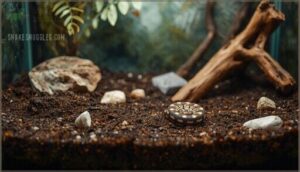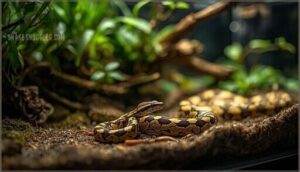This site is supported by our readers. We may earn a commission, at no cost to you, if you purchase through links.

The margin for error with hatchlings is razor-thin compared to adult snakes. Their smaller body mass means they dehydrate faster, lose heat more rapidly, and have less resilience when conditions drift outside their narrow comfort zone.
Getting the setup right before you bring your snake home isn’t just good practice—it’s the difference between a thriving pet and an emergency vet visit within the first month.
Table Of Contents
- Key Takeaways
- How to Prepare for a Baby Snake
- Setting Up a Safe Snake Enclosure
- Maintaining Proper Temperature and Humidity
- Feeding Guidelines for Baby Snakes
- Handling and Socializing Baby Snakes
- Monitoring Baby Snake Health
- Caring for Snake Eggs and Hatchlings
- Troubleshooting Common Baby Snake Problems
- Frequently Asked Questions (FAQs)
- Conclusion
Key Takeaways
- Baby snakes require three precise environmental conditions to survive: a warm side at 85°F, humidity between 40-60%, and feeding every five to seven days, with deviations of just a few degrees or percentage points potentially causing respiratory infections, regurgitation, or failure to thrive.
- Captive-born snakes have better survival rates and fewer health issues than wild-caught specimens, and you should select specimens with smooth, shiny skin, alert behavior, clear eyes, and uniform body structure while avoiding designer morphs with neurological problems like wobble syndrome.
- Proper substrate selection directly impacts hatchling health, with a DIY mix of 40% organic topsoil, 40% coconut fiber, and 20% play sand facilitating natural burrowing while maintaining 65-75% humidity and reducing the need for full replacements to once every 12-24 months.
- Most feeding refusals in baby snakes stem from temperature issues (affecting up to 85% of cases) or environmental stress, and can be resolved by maintaining proper tank temperatures between 75-90°F, offering pre-killed mice at body temperature, and allowing newly acquired snakes one to two weeks to acclimate before attempting to feed.
How to Prepare for a Baby Snake
Before you bring a baby snake home, you need to get three things right. First, understand what your specific species needs. Second, choose a healthy captive-born snake from a reliable source. Third, connect with a reptile veterinarian who can guide you through the early stages of care.
Researching Snake Species and Needs
Your first decision is choosing the right reptile species for your experience level and lifestyle. Over 3,600 snake species exist worldwide, each with distinct habitat requirements and care protocols. Corn snakes, ball pythons, and milk snakes are popular starter species due to manageable size and docile temperament.
You’ll need to research your chosen species’ specific temperature range, humidity levels, and feeding habits before bringing a hatchling home. Species identification matters because environmental needs can vary by up to 50% between common types. Understanding proper snake care basics is essential for creating a suitable environment.
Selecting a Healthy Captive-Born Snake
Captive-born snakes have better survival rates and fewer health issues than wild-caught specimens. Over 97% of snakes in the North American hobby market come from captive breeding operations.
Look for smooth, shiny skin without wounds or scale damage. Healthy baby snakes show alert behavior and clear eyes protected by transparent scales. Check for uniform body structure and regular breathing patterns. Request health certificates documenting the snake’s captive origin and breeding records.
Avoid designer morphs with neurological issues like wobble syndrome in spider ball pythons. Regular health checks are vital for maintaining a healthy snake environment.
Consulting a Reptile Veterinarian
Once you’ve confirmed your snake’s origin, find a reptile specialist with proper veterinary credentials before bringing your new pet home. Not all clinics offer exotic pet care qualified for snake health checks. Look for practitioners certified through the Association of Reptile and Amphibian Veterinarians.
Schedule your first appointment within the first week. This visit usually includes:
- Full-body assessment checking skin, oral cavity, and breathing patterns
- Baseline fecal testing to screen for parasites
- Discussion of species-specific husbandry requirements
- Access to reptile emergency services for after-hours care
An experienced reptile specialist can spot potential problems before symptoms appear. Most exotic pet exams cost between $65 and $80. This investment protects your snake’s health and gives you peace of mind as you start your journey in reptile care.
Setting Up a Safe Snake Enclosure
Your baby snake’s first home sets the foundation for its health and comfort. The right enclosure protects your snake while making daily care manageable.
Let’s walk through the key decisions you’ll need to make when building this safe space.
Choosing The Right Tank Material and Size
Your baby snake’s first home sets the foundation for its entire life. Glass aquariums with screen tops remain popular due to their visibility and availability, but material choice directly impacts temperature stability and maintenance. PVC enclosures retain heat 20% longer than glass tanks, reducing energy costs and creating more consistent thermal gradients. Acrylic offers similar benefits with 17 times higher shatter resistance than glass, though it scratches more easily over time.
Tank size depends entirely on your snake’s species and current length. A 10-gallon tank suits hatchling ball pythons under 300 grams, while juvenile corn snakes need at least 24 inches in length. The enclosure length plus width should equal or exceed your snake’s total body length to allow proper stretching and movement.
| Material | Heat Retention | Weight & Durability |
|---|---|---|
| Glass | Loses 20% more warmth; 8–10 lbs/gallon | High visibility; requires resealing after 7–10 years |
| PVC | Retains heat 20% longer; 40–60% lighter | Low water absorption; scratch-resistant matte finish |
| Acrylic | 10–15% better than glass; 50% lighter | 17x shatter resistance; scratches after 8–10 years |
| Ventilation | Screen tops reduce humidity 40% | Cross-ventilation prevents mold; 6–12 sq in recommended |
Ventilation systems need careful planning. Screen tops on glass aquariums can drop humidity by 40%, which may stress tropical species during shedding. Proper ventilation should include 6 to 12 square inches distributed between upper and lower panels to maintain airflow without excessive moisture loss.
Essential Enclosure Accessories and Decorations
Your snake needs specific accessories to thrive. Two hides—one warm and one cool—reduce stress by up to 70% during resting periods. Heavy ceramic water bowls prevent tipping and allow full-body soaking, especially before shedding.
Climbing structures like cork branches increase activity by 25% in hatchlings. Safe artificial plants provide cover and boost perceived security by 40%.
Avoid heating rocks, which cause burns, and guarantee proper ventilation throughout the enclosure.
Selecting Appropriate Substrate
Substrate materials directly affect your hatchling’s health and behavior. A DIY mix of 40% organic topsoil, 40% coconut fiber, and 20% play sand facilitates natural burrowing while maintaining 65-75% humidity. Bioactive options with cleanup crews reduce full replacements to once every 12-24 months.
- Fine coconut fiber minimizes ingestion risks during feeding compared to coarse bark chips
- Layering substrate 3-4 inches deep allows humidity control and natural digging behaviors
- Avoid sand or gravel for hatchlings—aspen shavings lower impaction rates by 8-12%
Maintaining Proper Temperature and Humidity
Temperature and humidity aren’t just nice-to-haves for your baby snake—they’re critical survival factors. Getting these conditions right means the difference between a thriving snake and one struggling to digest food or shed properly.
Here’s what you need to know to dial in the perfect environment.
Ideal Temperature Ranges for Baby Snakes
Think of temperature as your snake’s metabolism switch. Most baby snakes need thermal gradients between 75–90°F, with tropical species like ball pythons thriving at 82–88°F and temperate corn snakes preferring 75–85°F.
Basking zones should reach 88–92°F for proper thermoregulation and digestion. Maintaining consistent temperature control within 3°F prevents feeding refusals and fosters healthy growth.
Safe Heating Methods and Placement
Overhead heat lamps or under tank heating pads are your two safest heat source options when properly installed. For under tank heating, position heat mats beneath the enclosure covering only one-third of the floor to create essential temperature gradients. Install a thermostat on every heating element to maintain precise temperature regulation and prevent deadly overheating.
Always mount heat lamps 10–15 cm above mesh tops to prevent burns—young snakes can slip into lamp cages placed inside enclosures. Place your thermostat probe inside the warm hide above substrate, and check snake temperature daily in both basking and cool zones.
Never use heat rocks—they cause four times more thermal injuries than lamp or mat alternatives.
Monitoring and Adjusting Humidity Levels
Accurate humidity control protects your baby snake from respiratory infections and shedding problems. Place a digital hygrometer at ground level in the enclosure—it measures snake environment conditions more reliably than upper placements. Recalibrate every six months to maintain accuracy within 3%.
Add a medium water bowl to raise ambient moisture by 8%, and mist with dechlorinated water during evening hours when humidity naturally peaks.
For species requiring elevated snake humidity like ball pythons (60–80%), install humid hides lined with damp sphagnum moss to create microclimates 15% higher than baseline.
Feeding Guidelines for Baby Snakes
Feeding baby snakes properly is one of the most critical aspects of their care. Getting the diet right from the start ensures healthy growth and development.
Here’s what you need to know about selecting food, establishing a feeding schedule, and handling common feeding challenges.
Choosing The Right Food for Hatchlings
Hatchling snakes are obligate carnivores that need whole-prey items for complete nutrition. Your top feeding priorities include:
- Pinkie mice (1–4 days old) – The standard food source for most species due to soft body structure and easy digestion
- Frozen-thawed rodents – Safer than live prey, reducing injury risk by approximately 18% and preventing parasite transmission
- Species-specific options – Garter snakes require fish or amphibians, while king snakes may prefer lizard-scented prey initially
- Proper prey sizing – Select items no wider than 1–1.5 times the snake’s mid-body width
- USDA-certified suppliers – Source frozen prey from reputable vendors to guarantee nutritional standards and safety
Avoid wild-caught prey due to a 41% parasite risk.
Feeding Frequency and Meal Size
Your baby snake’s feeding schedule depends on age, species, and growth trajectory. Most hatchlings under 50 grams eat every 5–6 days, though some high-metabolism species like hognose snakes need meals every 3–4 days.
Meal size should equal 10–15% of body weight—a 10-gram corn snake gets a 1–2 gram pinkie. These feeding guidelines support ideal growth rates while allowing 48-hour digestion times between meals.
Monitor weekly weight gain to adjust your snake feeding habits as needed.
Tips for Encouraging Reluctant Eaters
Sometimes your baby snake won’t eat despite following proper snake feeding guidelines. Scent stimulation works well—rub prey with lizard or frog bedding to trigger feeding cues. Try “braining” frozen prey or warming it to body temperature for better prey presentation.
Vertical dangling mimics natural movement and reduces snake feeding challenges. Environmental enrichment, like adding hides, lowers stress, improving snake feeding habits.
Feed after dark when nocturnal instincts peak. Patience matters—most reluctant eaters accept food within five attempts.
Handling and Socializing Baby Snakes
Handling a baby snake isn’t something you should rush into. These delicate animals need gentle, intentional contact that respects their natural stress responses.
Here’s what you need to know about safely interacting with your hatchling.
Safe Handling Techniques
Proper posture makes all the difference when you’re working with a baby snake. Support the body evenly and avoid sudden movements that trigger defensive behavior.
- Support two-thirds of the body length to reduce spinal stress and prevent handling injuries.
- Use snake hooks or soft tongs for lifting without causing scale abrasion or compression.
- Never grip behind the head unless medically necessary, as this causes the majority of reptile injuries.
- Approach from the side rather than overhead to reduce perceived predation threat by over 50%.
- Apply gentle touch with clean hands to minimize bacterial transfer and maintain your pet snake’s health and safety.
Minimizing Stress During Interaction
Your interaction strategies shape your pet snake’s stress response. Choice-based handling protocols lower reptile stress by 37% when you let your baby snake explore on its own terms. Start with brief sessions under 10 minutes to prevent corticosterone spikes.
Gentle handling builds trust faster than restraint. Watch for calming techniques like slow tongue flicks and relaxed body posture, which signal your snake behavior is stable and healthy.
Recognizing Signs of Overhandling
Watch for stress indicators that reveal when your pet snake has reached its handling limits. Frequent door surfing, defensive posturing, or sudden refusal to eat point to overhandling signs that demand immediate attention. Studies show baby snakes handled daily experience measurable health impacts, including a 30-50% spike in stress hormones within 30 minutes.
Key overhandling signs include:
- Persistent escape attempts and pacing behavior (seen in 35% of overhandled juveniles)
- Meal refusal rates climbing to 17-24% among frequently handled hatchlings
- Defensive responses like musking or defecation during interaction
Limit sessions to twice weekly for ideal snake health and safety in your caring for baby snakes routine.
Monitoring Baby Snake Health
Keeping your baby snake healthy means watching for warning signs before small problems become serious. You need to know what normal looks like so you can spot changes quickly.
Let’s look at the key health indicators you should monitor and what steps keep your snake thriving.
Signs of Common Health Issues
Catching snake health concerns early can mean the difference between quick recovery and serious illness. Respiratory issues appear as wheezing or open-mouth breathing—affecting up to 80% of sick juveniles.
Skin problems like retained shed or scale rot develop when humidity drops below 40% or substrates stay wet.
Watch for digestive disorders such as bloating or regurgitation after feeding. Parasite control matters because internal parasites cause weight loss in 18% of hatchlings.
Septicemia signs include reddened belly scales and sudden lethargy—this serious condition causes 20% of reptile deaths.
Importance of Regular Veterinary Visits
Regular veterinary visits form the foundation of effective disease prevention and early health intervention. Reptile-focused veterinarians detect hidden parasites in 70–85% of baby snakes during routine exams—often before symptoms appear.
Annual health checks establish baseline records that improve diagnostic accuracy by 33% and reduce emergency situations markedly. Your vet provides medical guidance on parasite control, feeding protocols, and environmental adjustments customized to your snake’s species.
Professional snake veterinary care extends lifespan by an average of 28% compared to snakes receiving only emergency treatment.
Maintaining Cleanliness in The Enclosure
Think of your snake enclosure as a petri dish—without proper Enclosure Sanitation, bacteria multiply rapidly. Daily spot cleaning removes fecal matter and uneaten food from your snake tank, minimizing bacterial buildup.
Wash the hide box and water bowl weekly with reptile-safe Disinfectant Options like F10 or diluted chlorhexidine. Complete Substrate Replacement and deep cleaning should occur every one to three months.
These Hygiene Protocols reduce Salmonella risk by 80% and prevent respiratory infections in hatchlings.
Caring for Snake Eggs and Hatchlings
If you’re breeding snakes or purchasing eggs, understanding incubation is essential for success. The conditions you provide during those critical weeks will determine whether your hatchlings emerge healthy and strong.
Here’s what you need to know about creating the right environment and caring for newly hatched snakes.
Incubation Temperature and Humidity Needs
Successful breeding success depends on precise incubation temperature and humidity levels for snake egg incubation. Most python species need temperatures between 88–92°F, while corn snakes thrive at 78–84°F. Humidity levels should stay around 80–90% for pythons and 75–85% for colubrids.
Temperature fluctuations beyond 2°F can reduce hatching rates by 20% and extend incubation time. Monitor both parameters closely—eggs losing over 15% of their weight signal dangerously low humidity.
Setting Up an Incubation Environment
Creating the right incubation environment protects developing embryos and boosts hatch rates above 90%. Your setup needs three essential components:
- Incubator Selection – Use a polypropylene container with a transparent lid for monitoring without disrupting conditions during the incubation period.
- Substrate Preparation – Mix vermiculite with water at a 2:1 ratio by weight to maintain snake egg humidity between 60–70%.
- Ventilation Systems – Add 2–4 pinholes for gas exchange while preserving moisture levels throughout snake egg incubation.
Digital thermometers maintain snake egg temperature within ±0.2°C for ideal development.
First Steps After Hatching
Once hatchling snakes emerge, you’ll want to transfer them into individual containers within 24 hours. Keep the post-hatch environment warm—between 75–85°F for temperate species—and maintain 60–70% humidity. Don’t handle them yet or offer food right away.
Hatchlings have yolk reserves that sustain them for weeks. Most feeding hatchling snakes begins after their first shed, usually 7–14 days post-hatching. This waiting period aids healthy snake development and reduces stress during early handling phases.
Troubleshooting Common Baby Snake Problems
Even the healthiest baby snakes can run into problems that leave you wondering what went wrong. From skipped meals to stuck shed, these challenges are common but manageable with the right approach.
Let’s walk through the most frequent issues you’ll encounter and how to handle them.
Addressing Feeding Refusals
Frequently, feeding baby snakes becomes challenging when environmental stress or improper temperatures disrupt appetite. Up to 85% of feeding refusals stem from temperature issues—keep your tank between 75 and 90°F for most species.
If your hatchling snake refuses food, check humidity levels and hiding spots first. Try scenting prey with lizard skin or use the braining technique, which works in 80% of reluctant eaters.
Offering pre-killed mice at proper body temperature improves feeding success dramatically. Give newly acquired snakes one to two weeks to acclimate before worrying.
Dealing With Shedding Difficulties
Like feeding, snake shedding problems often signal humidity control issues. Roughly 75% of shedding difficulties in baby snakes trace back to dry air. When skin retention occurs, you’ll notice patchy areas or cloudy eye caps after your snake’s shed cycle.
Here’s how to handle shedding issues effectively:
- Boost humidity to 60–70% using a digital hygrometer—this prevents 35% of stuck shed cases.
- Add a humid hide filled with damp sphagnum moss to reduce retention by 31%.
- Soak your snake in lukewarm water for 15 minutes, which resolves 79% of mild cases.
- Include rough surfaces like bark or stones for natural shed removal assistance.
- Seek veterinary intervention if retained skin persists beyond 10 days or causes discoloration.
Retained eye caps affect 5–8% of juvenile shedding events and can lead to blindness without treatment. Monitor your hatchling closely during each shed cycle.
Preventing Illness and Parasites
Your snake’s health defense begins with smart parasite control and disease prevention habits. Weekly disinfectant cleaning reduces bacterial loads by 72%, while daily water changes limit bacterial regrowth in warm enclosures.
Mites infect up to 17% of captive reptiles and spread viral diseases like IBD through contaminated surfaces. Quarantine new snakes for 30 days to cut parasite transmission by 84%.
Schedule fecal screenings every three months to detect internal parasites early, and wash your hands for 20 seconds after handling to prevent Salmonella exposure—these hygiene practices protect both reptile health and pet safety.
Frequently Asked Questions (FAQs)
What water sources are safe for baby snakes?
Your pet snake needs clean water, just like you’d grab a canteen for a hike. Bottled spring water works best for your water dish since it lacks chlorine. Tap water requires dechlorination treatment or 24-hour standing time.
Filtration methods help guarantee water quality and proper hydration for snake care guide success.
How often should you clean a snake tank?
You should spot clean your snake tank daily to remove waste and change water.
Complete deep cleaning with reptile-safe disinfectants like chlorhexidine every three to four months to prevent bacterial growth and maintain snake health.
Can baby snakes live together in one enclosure?
Most baby snakes should live separately. Cohabitation risks stress, aggression, and even cannibalism.
Territorial species like ball pythons need individual housing, while garter snakes tolerate tank mates better if space and resources allow.
When do baby snakes start shedding their skin?
Hatchling snakes usually shed their skin for the first time within 5 to 12 days after hatching.
This first shed timing varies by species and growth factors like temperature and nutrition, marking an important benchmark in snake development.
What sounds or noises stress baby snakes out?
Loud sounds exceeding 85 decibels cause auditory stress in hatchling snakes. High-frequency sounds above 1,000 Hz and sudden noises trigger defensive behaviors.
Bass-heavy vibrations below 50 Hz create vibrational stress through the ground, impacting snake health and wellness in captivity.
Conclusion
You might think memorizing these numbers feels overwhelming, but most issues trace back to just one or two overlooked details. Once you’ve dialed in your enclosure’s heat gradient and humidity, how to care for baby snakes becomes a straightforward rhythm of observation and adjustment.
Your hatchling’s behavior will tell you what’s working and what needs fine-tuning. Watch for steady feeding, clean sheds, and confident movement—these are your proof that you’ve created an environment where your snake doesn’t just survive, but thrives.
- https://reptizoo.store/blogs/reptizoo-reptiles-blogs/how-to-care-for-baby-corn-snake-care-sheet
- https://www.petmd.com/reptile/corn-snake-care-sheet
- https://www.facebook.com/groups/everythingballpythons/posts/1524625074846013/
- https://reptifiles.com/corn-snake-care-guide/corn-snake-temperatures-humidity/
- https://community.morphmarket.com/t/feeding-schedule-for-current-age-weight/46373















